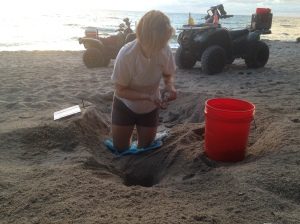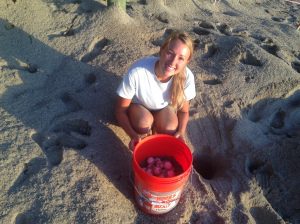Along with the change of season from summer to fall, our research department also changes their daily routine in October. This month, the daily nesting surveys typically end and the field technicians will be finishing up their data collection. We will still be out on the beach every day to check on the remaining marked nests and complete nest excavations. The daily nesting surveys are conducted from March 1-September 30 along Juno and Jupiter beaches and from March 1-October 15 on Tequesta beaches. As of October 7, the research department has documented 11,634 nests (268 leatherback, 10,387 loggerhead and 979 green) along Juno, Jupiter and Tequesta beaches.
This year, we have extended the daily survey of Jupiter until the end of November or when sea turtle crawls have been observed in Palm Beach County for at least 14 days (whichever is earlier). LMC biologists have been contracted to relocate any nests laid in the northern section of Jupiter Beach for two nourishment projects that are scheduled to begin as early as November 2014. In Florida, it is requirement that construction companies hire trained sea turtle monitors, like LMC’s staff biologists, to conduct sea turtle monitoring and relocate nests. Sea turtle nests can take up to 70 days to incubate and for this reason, our staff began to relocate all nests will be harmed by the construction equipment or activities in November.
As of October 7, we have successfully relocated six sea turtle nests (1 loggerhead and 5 green turtles). The nests are moved with the utmost care. Each egg must be removed from the nest individually and placed into a bucket or cooler filled with sand for transport without any rotation of the egg. The reason for this is that shortly after sea turtle eggs are laid the embryo will begin to attach itself to the side of the egg. It is crucial that the egg not be rotated during incubation to ensure that the embryo remains attached to the sidewall (unlike bird eggs which can be moved around while in the nest). The eggs are then transported to the relocation site and a new egg chamber is dug to match the dimensions of the original chamber. And, once again the eggs are placed back into the sand one by one. Typically, relocated nests successfully incubate and result in a comparable emergence success to nests left in their original location, or in situ. We are anticipating the first relocated nest to hatch in mid-November.


